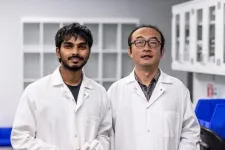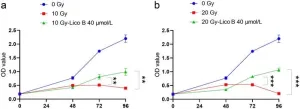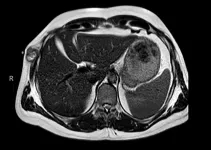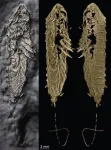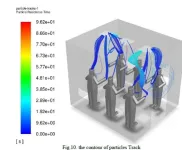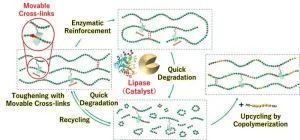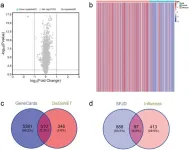(Press-News.org) University of Texas at Dallas mechanical engineers have designed a 3D-printed femur that could help doctors prepare for surgeries to repair bones and develop treatments for bone tumors.
The engineers, who worked in collaboration with UT Southwestern Medical Center orthopedic surgeons, published their first study on the 3D-printed thigh bone online Aug. 5 in the Journal of Orthopaedic Research.
The study, which focused on the middle section of the bone, establishes 3D-printing parameters for a femur for use in biomechanical testing. Researchers said more studies will be needed before the technology could be available for widespread use.
To study and validate innovative surgical implants and techniques, surgeons perform biomechanical studies using donated cadavers or commercially available synthetic bones, which help them determine optimal surgical fixation and predict the response of the bone. Synthetic bones, also used in surgical training, can be expensive, take time to acquire and lack the ability for patient-specific solutions.
UT Southwestern researchers approached Dr. Wei Li, a UT Dallas expert in 3D-printing technology, two years ago to collaborate on a less costly and faster alternative for orthopedic biomechanical studies.
“To make plans for surgery, surgeons need to know the geometry of the bone,” said Li, assistant professor of mechanical engineering in the Erik Jonsson School of Engineering and Computer Science and corresponding author of the recent study. “With 3D printing, we’re able to print out the femur bone sample with the same geometry of the femur inside the body.”
Through trial and error, UTD mechanical engineering doctoral student Kishore Mysore Nagaraja developed many iterations of the femur. Mysore Nagaraja, who works in Li’s Comprehensive Advanced Manufacturing Lab, performed a series of tests on each artificial bone to measure mechanical performance and material properties to make the samples as similar as possible to real femurs.
“This collaborative experience is the best thing a student could ask for,” said Mysore Nagaraja, who is expected to graduate in December. “To get an evaluation of my testing research directly from the doctors who are going to use it is a very good validation of our research.”
The bone replica is made of polylactic acid, a bio-based, low-cost biodegradable polymer commonly used in 3D printing. The design, which represents the midsection of the femur, is almost 8 inches long and nearly 1 inch in diameter. In biomechanical tests, it performed as well as a human femur. Researchers estimated each 3D-printed femur cost $7 to make.
Li said 3D-printed bones have a range of potential applications. The polymer, for example, might replace other materials used in bone repair, such as titanium. Li said researchers also could print tumors onto 3D-printed bones and test treatments on the printed samples, or the replicas might be used to help grow human bone tissue.
UT Southwestern researchers involved in the study included first author Dr. Robert Weinschenk, an orthopedic oncology surgeon, and Dr. Richard Samade, a hand and upper extremity surgeon, who run a 3D-printing lab. Both are assistant professors of orthopedic surgery with secondary appointments in biomedical engineering; Samade has a secondary appointment in plastic surgery.
“I reached out to Dr. Li and his team, and fortunately this has turned into an excellent collaboration between us,” Weinschenk said. “With the knowledge and skill sets Dr. Samade and I have as surgeons — both with engineering backgrounds — in combination with Dr. Li’s tremendous knowledge and expertise in mechanical testing and his amazing resources, our collaborative team is uniquely poised to try to tackle these types of challenges.”
Additional authors were former UTD student Faiqa Alam BS’23, and Dr. Blaine Oldham, who graduated from UT Southwestern in May.
END
Researchers Aim To Get Leg Up on Bone Repair with 3D-Printed Femur
2024-10-29
ELSE PRESS RELEASES FROM THIS DATE:
Transforming patient care: study finds bedside interdisciplinary rounds boost satisfaction for patients and providers
2024-10-29
A study led by researchers at the University of Colorado Anschutz Medical Campus reveals patients and providers have more positive overall care experiences when the entire healthcare team is a part of bedside interdisciplinary rounds (BIDR).
The study published today in the Journal of General Internal Medicine.
The study found that BIDR, when the team meets at a patients’ bedside in the hospital to discuss care plans, helps build trust between patients and their healthcare providers and within healthcare teams by allowing everyone to observe and work together more closely.
“Traditional ...
Radioprotective effects of licochalcone B: DNA protection, cytokine inhibition, and antioxidant boost
2024-10-29
Background and objectives
Radiation injury poses a serious threat to human health, causing complex and multifaceted damage to cells and tissues. Such injury can be caused by various factors, including nuclear accidents, medical radiation therapy, and space travel. Currently, finding effective treatment methods and drugs to mitigate the harmful effects of radiation injury on the human body is a crucial research direction. This study aimed to explore the protective effects and mechanisms of Licochalcone ...
Complete response to encorafenib + binimetinib in BRAF V600E-mutant tumor
2024-10-29
“This case report highlights the importance of full tumor genotyping to identify potentially actionable targets in rare tumors such as malignant glomus tumors.”
BUFFALO, NY- October 29, 2024 – A new case report was published in Oncotarget's Volume 15 on October 11, 2024, entitled “Complete response to encorafenib plus binimetinib in a BRAF V600E-mutant metastasic malignant glomus tumor.”
As highlighted in the abstract, glomus tumors (GT) are rare mesenchymal neoplasms originating in dermal arteriovenous structures involved in thermoregulation. ...
Gold bugs: Spectacular new fossil arthropod preserved in fool’s gold
2024-10-29
UNDER EMBARGO UNTIL 15:00 GMT / 11:00 ET TUESDAY 29 OCTOBER 2024
Gold bugs: spectacular new fossil arthropod preserved in fool’s gold
Images available via link in the notes section
A new 450-million-year-old fossil arthropod, preserved in 3D by iron pyrite (fool’s gold), has been unveiled by scientists.
The new species, Lomankus edgecombei, is distantly related to spiders, scorpions, and horseshoe crabs.
The findings have been published today (29 Oct) in the journal Current Biology.
A team of researchers led by Associate Professor Luke Parry, Department of Earth Sciences, University of Oxford, have unveiled a spectacular ...
Optimal standing positions and ventilation in airport smoking lounges
2024-10-29
WASHINGTON, Oct. 29, 2024 – While many smoking rooms in U.S. airports have closed in recent years, they are still common in other airports around the world. These lounges can be ventilated, but how much does it actually help the dispersion of smoke?
Research published in Physics of Fluids, by AIP Publishing, shows that not all standing positions in airport smoking lounges are created equal.
Researchers from the University of Hormozgan in Iran studied nicotine particles in a simulated airport smoking room and found that the thermal environment and positioning of smokers influenced how particles ...
Ancient gene influences immunity of First Nations Peoples of Oceania
2024-10-29
AURORA, Colo. (Oct. 29, 2024) – An ancient gene mutation among First Nations inhabitants of Oceania may make them more susceptible to infectious diseases like influenza, according to a new study by scientists at the University of Colorado Anschutz Medical Campus.
“We found quite a diverse set of genes in this population but there was one allele that really stood out in terms of genetic composition,” said the study’s lead author Paul Norman, PhD, professor of biomedical informatics at the University of Colorado School of Medicine. “We did some investigating, and we suspect this allele ...
The Megacheiran candidate: Fossil hunters strike gold with new species
2024-10-29
New Haven, Conn. — Paleontologists have identified fossils of an ancient species of bug that spent the past 450 million years covered in fool’s gold in central New York.
The new species, Lomankus edgecombei, is a distant relative of modern-day horseshoe crabs, scorpions, and spiders. It had no eyes, and its small front appendages were best suited for rooting around in dark ocean sediment, back when what is now New York state was covered by water.
Lomankus also happens to be bright gold — thanks to layers of pyrite ...
Advanced biodegradable plastics run rings around their predecessors
2024-10-29
Osaka, Japan—Achieving a sustainable society requires the development of advanced degradable plastics, or polymers, which are molecules composed of long chains of repeating units. The goal of a resource-circulating society is now one step closer thanks to the efforts of a team from Osaka University that has developed tough biodegradable plastics by including movable crosslinking groups.
In a study published this month in Chem, the researchers have revealed that developing polymers with movable crosslinks not only increases their strength but also promotes degradation by enzymes under mild conditions.
Plastics and polymers need to achieve both desirable performance ...
Suicide-related emergencies underdetected among minority, male youth, and preteens, study finds
2024-10-29
A new study by UCLA Health reveals that hospital emergency departments may be missing signs of suicidal thoughts and behaviors in children, boys and Black and Hispanic youth.
The research, published in the journal JAMA Open Network, analyzed electronic health records of nearly 3,000 children and teenagers presenting to two emergency departments in southern California for mental health reasons. Using machine learning algorithms, the researchers determined standard medical record surveillance methods miss youth with suicide-related emergencies. These methods disproportionately missed suicide-related visits among Black, Hispanic, male, and preteen youths, compared with ...
The molecular mechanism of Shufeng Jiedu capsules in the treatment of influenza: A comprehensive analysis based on network pharmacology, bioinformatics, and molecular docking
2024-10-29
Background and objectives
Shufeng Jiedu Capsules (SFJD), a traditional Chinese medicine preparation, are widely used in the clinical treatment of influenza, yet their mechanism of action remains unclear. This study aimed to systematically explore the molecular mechanism of SFJD in the treatment of influenza using network pharmacology and bioinformatics techniques.
Methods
The active ingredients of SFJD were retrieved from traditional Chinese medicine databases, and their targets were identified using the Swiss Target Prediction and TCMSP databases. Influenza disease genes were obtained from the GEO, GeneCards, and DisGeNET ...
